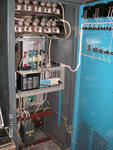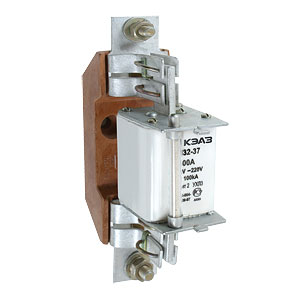Fuse to protect supply valves
 For the protection of power valves of semiconductor converters of medium and large sizes, external and internal short-circuit capacities, fast-acting fuses, which are the cheapest means of protection, are widely used. They consist of contact knives and a fusible insert of silver foil placed in a sealed porcelain cartridge.
For the protection of power valves of semiconductor converters of medium and large sizes, external and internal short-circuit capacities, fast-acting fuses, which are the cheapest means of protection, are widely used. They consist of contact knives and a fusible insert of silver foil placed in a sealed porcelain cartridge.
The fuse of such fuses has narrowly calibrated leads, which are equipped with radiators made of highly thermally conductive ceramic material, through which heat is transferred to the fuse body. These heatsinks also serve as arc chutes with a narrow slot that greatly improves isthmus arc suppression. Parallel melting in the insert, a signal cartridge is installed, the flasher of which signals the melting of the fuse inserts, and the impact on the microswitch closes the signal contacts.
 The main indicators fusewhich characterize its protective properties are rated voltage, rated fuse current, thermal equivalents of melting and breaking.
The main indicators fusewhich characterize its protective properties are rated voltage, rated fuse current, thermal equivalents of melting and breaking.
For a long time, the industry produced two types of high-speed fuses designed to protect against short-circuit currents of converters with semiconductor valves for power supply:
 1) PNB-5 type fuses for operation in circuits with rated voltage up to 660V DC and AC for rated currents 40, 63, 100, 160, 250, 315, 400, 500 and 630 A,
1) PNB-5 type fuses for operation in circuits with rated voltage up to 660V DC and AC for rated currents 40, 63, 100, 160, 250, 315, 400, 500 and 630 A,
2) PBV type fuses for operation in alternating current circuits with a frequency of 50 Hz and a nominal voltage of 380 V for nominal currents from 63 to 630 A.
Currently, semiconductor converters equipped with fuses of the PP57 series, designed to protect converter devices with internal short-circuit AC and DC circuits at a voltage of 220-2000 V for currents of 100, 250, 400, 630 and 800 A.
Fuses can be mounted in series in the circuit of each valve, and in separately controlled reversing converters, one fuse protects the Group Forward and Group Reverse valves.
By paralleling valves in shoulder guards can be installed in series with each valve or one guard for all valves.
Selection of fuses for semiconductor protection elements
The fuse is characterized by the effective values of voltage and current and its selection is made from the following conditions
1) the rated voltage of the fuse used must be no less than the rated voltage of the converter installation. Otherwise, it will not be provided with normal arc extinction, which may lead to the destruction of the fuse housing and over-arcing of live parts. The response time of the fuse is 10-15 ms.
2) rated fuse base current when the fuse is installed in series with the valve:
where n is the number of gates connected in parallel.

PP57 series fuses
The fuses of the PP57 series are designed to protect converter blocks with powerful silicon semiconductor valves in case of internal short circuits in alternating or pulsating current circuits with a frequency of 50 and 50 Hz and in direct current circuits.
Name of fuses PP 57-ABCD-EF:
The letters PP — fuse;
Two-digit number 57 — conditional number of the series;
A — two-digit number — symbol of the rated current of the fuse;
B — figure — symbol of the rated voltage of the fuse;
C — number — conventional designation according to the method of installation and the type of connection of wires to fuse terminals (for example, 7 — on the wires of the converter device — with bolts with corner outlets);
D — number — symbol for the presence of an indicator of operation and contact of an auxiliary circuit: 0 — no indicator of operation, no contact of an auxiliary circuit; 1 — with a shutdown indicator, with an auxiliary circuit contact; 2 — with an indicator of operation, without contact of an auxiliary circuit;
E — letter — conventional designation of the climatic version; F — digit — placement category.
Example fuse symbol: PP57-37971-UZ.
The contacts of the auxiliary circuit withstand a load of 1 A in continuous operation at a nominal voltage of 220 V DC or 380 V AC.
